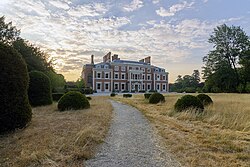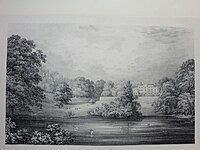Heckfield Place
| Heckfield Place | |
| Hampshire | |
|---|---|
 Heckfield Place | |
| Location | |
| Grid reference: | SU73206106 |
| Location: | 51°20’38"N, -0°57’1"W |
| History | |
| Built 1763 – 1766 | |
| For: | Jane Hawley |
| Country house | |
| Neo-classical | |
| Information | |
| Condition: | Converted to a hotel |
| Website: | www.heckfieldplace.com |
Heckfield Place is a Georgian country house within a 438-acre country estate in Hampshire.
The house was built between 1763 and 1766 for Jane Hawley (1744–1815), it was enlarged by the Shaw Lefevre family who lived in the estate from 1786–1895. In the 20th century, it was owned by the family of Colonel Horace Walpole before being sold to Racal Electronics plc. and converted to a conference and training centre in 1981–1982.
An additional wing was added to the north of the manor house, extending into the walled garden. From 2000 to 2002, Heckfield Place was run as a corporate training centre by the Thales Group. The building underwent major refurbishment from 2009 until 2018, when it opened as a luxury country house hotel and awarded The Sunday Times’ Hotel of the Year Award in 2018.[1]
Today the house is a luxury hotel and a Grade II listed building.[2][3]
History
Jane Hawley (1744–1815), the elder daughter of Revd John Baker of Ilton, Somerset (1713–1757), began the construction of the five-bay core of Heckfield Place manor house after the death of her husband, William Hawley of West Green House, Mattingley around August 1763. Jane had been orphaned (1757) and married (still a minor, in 1760), became a mother (1761) and then a widow (1763) all in around six years, and she was still not yet twenty years old.
She borrowed against the funds left in trust for her infant son Henry, and used some of the money to build herself a new house and amass a small estate.[4] The choice of the site for Heckfield Place appears to have been influenced by the proximity of her uncle and guardian, William Baker (1716–1800) and aunt Sarah with whom lived Jane’s younger sister Catherine, at a house called The Grove (part of the Stratfield Saye estate of George Pitt), on Heckfield Heath. The site was also high, pleasant, and healthy,[5] and afforded magnificent views to the north-east towards Windsor.
The architect of the house is not known. It was brick-built, three-storey (with a stone staircase), of five bays, with five rooms on the ground floor.[6] To make the most of the views down a small valley, the garden front faced east, and the main entrance was on the west front. Late 18th-century maps suggest three outbuildings to the north and north-west. These included ‘a double coach-house, and good stabling for ten horses.’ Advertisements for the letting of West Green, in July 1766 suggest that Heckfield Place was completed by this date.
In 1786 the Heckfield Place estate was sold, at which time it extended to about 120 acres. It was bought by John Lefevre (1721/2-1790) of a successful Huguenot family of textile dyers, gin distillers and bankers established around Spitalfields in London and Stratford, Essex. The estate passed to his daughter and her husband, Charles, who as a condition of marriage and inheritance added the name ‘Lefevre’ to his own.
The Shaw Lefevres enlarged the Rush house by the addition of identical wings to the north and south. Servants’ quarters, walled gardens, an ice house, stables and coach houses were also built, and the upper lake created. The Grove (possibly used as their home while the works were on-going) appears to have been demolished by 1818. By 1790, he had also acquired the present-day Home Farm acreage. He and his son greatly enlarged the estate, particularly to the south, until it extended to 2,388 acres.[7]
Charles and Emma Shaw Lefevre undertook two further phases of work to the manor house: by 1840.

In May 1839 Shaw Lefevre was elected Speaker of the House of Commons and after the dissolution of Parliament in 1841, he retained the post – the first Speaker to do so after a change of governing party: thus Shaw Lefevre was able to ‘establish a powerful tradition of political neutrality for its future presiding officers to follow.’[8] He was ennobled as Lord Eversley.
The Head Gardener from 1865 was William Wildsmith (1837–1890), who became one of the foremost men of his profession, leading the contemporary development of carpet bedding (for which the terrace at Heckfield Place was famous) from over-fussy floral patterns of annuals into looser, hardy, year-round planting. Wildsmith sat on fruit committees at Kew Gardens, wrote columns for contemporary journals. He also won for Heckfield Place a reputation as a top training ground for outstanding gardeners. He extended sub-tropical planting around the lower lake; the pinetum flourished in the native heathland soil, and included early sequoiadendron specimens; fifteen men tended the shrubberies; glass frames of every description enabled the unseasonal forcing of produce, for example of strawberries for the table in February; the walled gardens were legendary for fruit – for pears (the favourite fruit of Lord Eversley) and for grapes in particular. The grape room could preserve up to 2,000 bunches, enabling dessert grapes to be offered on the dining table every day of the year. The Heckfield Place garden was opened to the public, and in 1882 drew 2,000 visitors in five days. The Journal of Horticulture and Cottage Gardener that year described it as ‘a model garden both in design and execution. Surpassed by none and equalled by few.’[9]
Lord Eversley's died aged 94 in 1888, and the estate was put up for sale in 1895.

Colonel Horace Walpole (1849–1919) bought the Heckfield Place estate in July 1895. Improvements were made by Col Walpole to the house, including the installation of electricity, redigging the drains, and the building of a brick tower near the walled gardens, to distribute water pumped from a nearby spring, to the house, cottages and gardens.
In 1977 the estate was sold.
Conference and training centre, and hotel
Heckfield Place and sixty-seven acres[10] were bought by Patrick Hungerford and Toby Ward in 1981 and converted to a training and conference facility, acquired by Racal Electronics the following year. Racal’s customers, particularly military radio users, attended training at Heckfield Place through the 1980s, resulting in an eclectic mix of international guests. In the mid-1980s, Racal began the move into mobile 'phones, launching Vodafone in January 1985 after selling off much of Racal to Thales. Heckfield Place now became essentially a Vodafone staff training centre. The house was run as Thales Commercial University until its sale to the current owner in 2002.
From 2009 the manor house underwent extensive renovation prior to opening in September 2018 as a hotel with restaurants, a spa and screening room. The 220 acres of pleasure grounds, former site of The Grove, and the 180-acre Home Farm form a consolidated landholding, fringed by its own woodland, and by fishing on the River Whitewater.
Outside links
References
- ↑ 'https://www.thetimes.co.uk/article/heckfield-place-hampshire-best-british-hotels-kvxl0xbpw Hotel of the Year: Heckfield Place, Hampshire]': Duncan Craig in The Times
- ↑ National Heritage List 1092255: Heckfield Place (Grade II listing)
- ↑ National Heritage List 1001379: Heckfield Place (Register of Historic Parks and Gardens)
- ↑ Berkshire Record Office ref D/EHR E4/10 William Baker to Henry Hunter 5 February 1786
- ↑ Advertisement for the letting of The Grove, Reading Mercury, 12 June 1780 via British Newspaper Archive on-line (https://www.britishnewspaperarchive.co.uk/)
- ↑ Reading Mercury Monday 4 July 1785 sales advertisement
- ↑ Return of Owners of Land, 1873
- ↑ F. M. G. Willson A Strong Supporting Cast pp. 101–102
- ↑ 9 November 1882, pp. 130–132
- ↑ 'Heckfield: The Hamlet, The Estate, a window into British History' published by Heckfield Place Ltd in October 2003